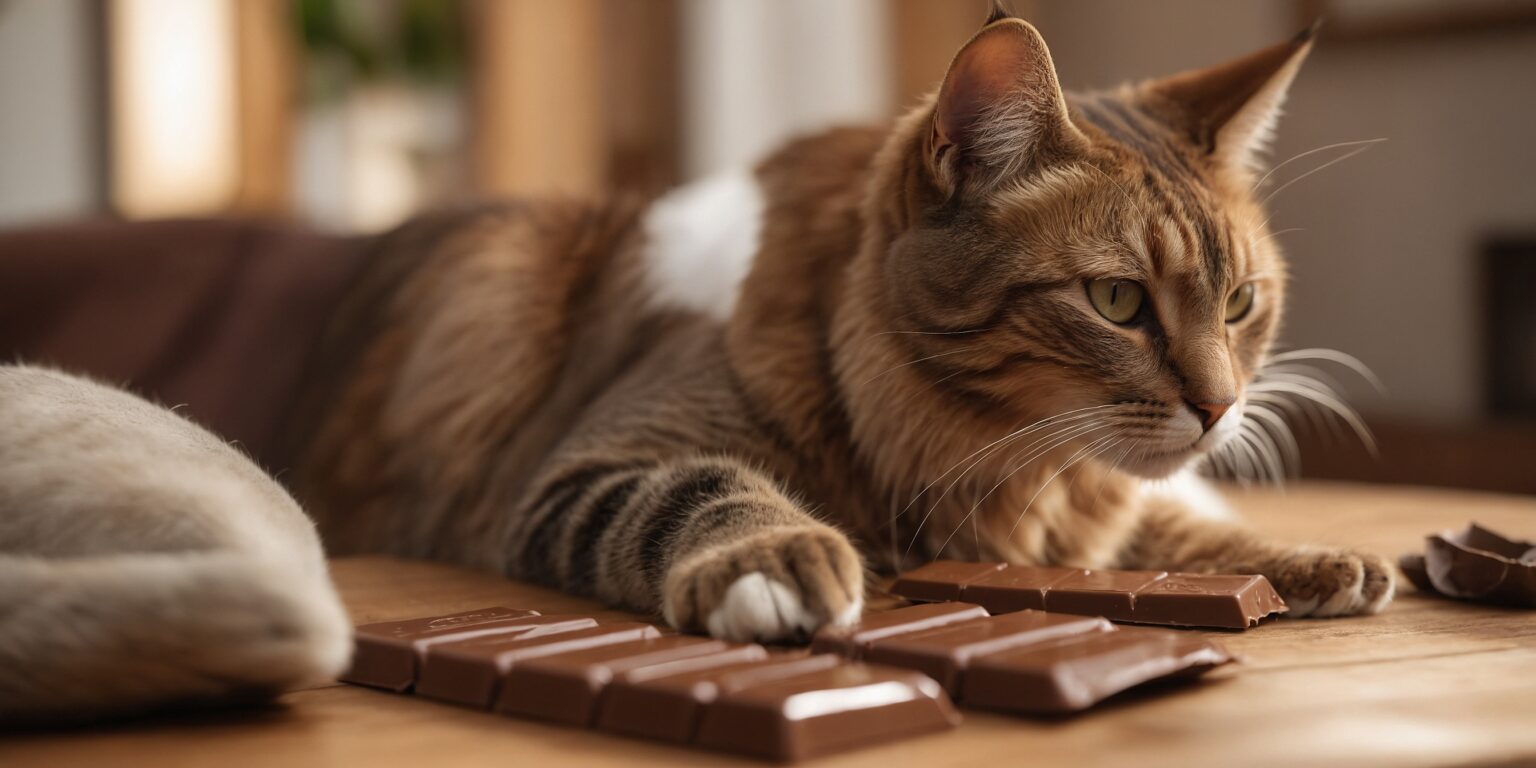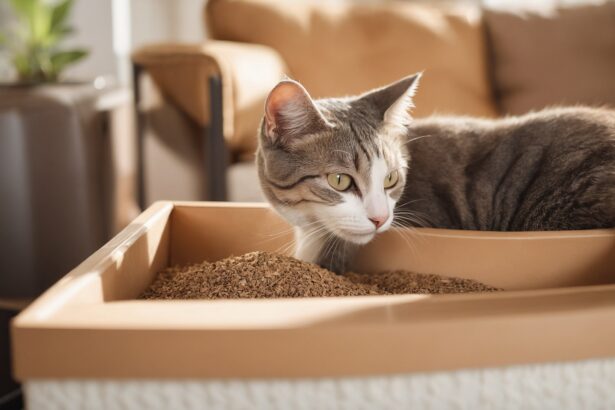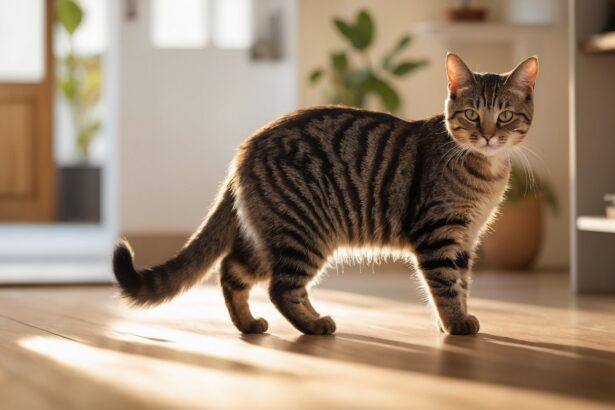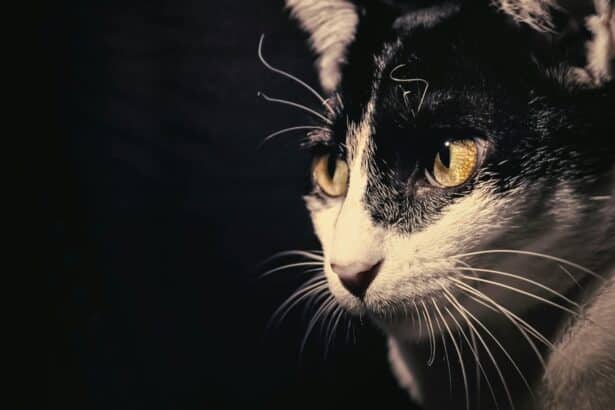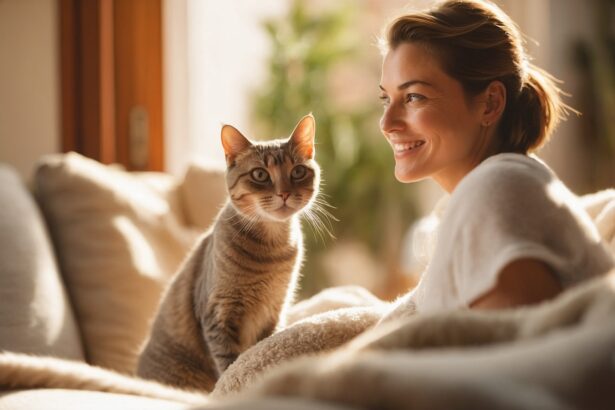Introduction
Why is chocolate dangerous for your cat? Because a tiny nibble can lead to big trouble for a feline’s heart and nervous system. Even if you’re tempted to share a sweet moment, chocolate is one human treat that must stay off your kitty’s menu.
Here’s the good news: once you know the risks, it’s easy to prevent accidents and still spoil your little whiskered love safely. Ready to protect your purr machine?
Why chocolate is toxic for cats
Theobromine and caffeine: the real culprits
Chocolate contains methylxanthines—mainly theobromine and caffeine—that cats can’t metabolize efficiently. These compounds overstimulate their system, which may cause vomiting, agitation, tremors or heart rhythm issues.
Surprising fact: cats can’t taste sweetness like we do. They lack the sweet-taste receptor, so if a cat shows interest in chocolate, it’s usually because of the fat, milk, or smell—not the sugary flavor.
Which chocolate is most dangerous?
- Baking chocolate and cocoa powder: highest theobromine levels; the most dangerous.
- Dark chocolate: very risky due to higher cocoa content.
- Milk chocolate: still toxic, especially if eaten in larger amounts.
- White chocolate: minimal theobromine, but not safe due to fat and sugar—avoid it.
Rule of paw: the darker and more bitter the chocolate, the higher the risk—so treat all chocolate as off-limits.
Symptoms of chocolate poisoning in cats
Signs can appear within hours and vary with the type and amount of chocolate. Watch closely if you suspect ingestion.
- Vomiting, diarrhea, restlessness
- Rapid breathing, increased heart rate
- Muscle tremors, twitching, sensitivity to noise/light
- In severe cases: collapse, seizures
Not sure if your cat actually ate some? When in doubt, call the vet. To support long-term tummy comfort, you may also appreciate our guide on why cats vomit and how to help.
What to do if your cat eats chocolate
Act fast, breathe, and call your vet
Stay calm and phone your veterinarian or an emergency clinic. Share what was eaten (type of chocolate, estimated amount, cocoa percentage if known), when it happened, your cat’s weight, and any health conditions.
- Common mistake to avoid: never try to make your cat vomit at home (e.g., with hydrogen peroxide). This can be dangerous for cats and may worsen the situation.
- Keep the wrapper—it helps identify the cocoa content.
- Do not wait for symptoms; earlier care often means better outcomes.
What your vet may do
Depending on timing and severity, your vet may use treatments to limit absorption (such as activated charcoal), provide fluids, manage heart rhythm, or control tremors and seizures. For medical details on chocolate toxicity, see the Merck Veterinary Manual.
If your cat is prone to sensitive digestion more generally, keep a feeding routine and review safe food options. Here’s a practical primer on what cats should really eat.
Everyday prevention that truly works
Keep cocoa out of curious paws
- Store chocolate (and cocoa powder) in high, closed cupboards or latched containers.
- Never leave brownies, truffles, or wrappers on coffee tables or in handbags.
- Brief guests and kids: “chocolate is for humans only.”
Pro tip to avoid accidents
Create a “party-safe stash”: keep a small jar of cat-approved treats on the counter. When friends visit with chocolate desserts, they can offer your cat a safe nibble from the jar instead—your kitty gets attention, your desserts stay out of reach.
Hidden traps you might not expect
- Chocolate-coated nuts and candies in open bowls.
- Cocoa powder used for dusting desserts—light and easy to lick.
- Cocoa mulch outdoors; while cats are less tempted than dogs, it’s still best avoided in gardens with feline visitors. If you’re greening your home, also check which plants are dangerous for cats.
Safe, delicious alternatives to spoil your cat
Cat-specific treats and quick homemade ideas
Choose commercial cat treats or offer tiny amounts of plain, cooked chicken or fish as an occasional reward. Keep treats to about 10% of daily calories to protect your cat’s waistline and health.
Making something at home? Avoid onions, garlic, grapes/raisins, alcohol, and artificial sweeteners. When in doubt, ask your vet and stick to simple, cat-friendly recipes. For broader nutrition guidance, here’s a helpful read on balanced feline diets.
Non-food rewards your cat will adore
- Short interactive play bursts with a wand toy
- New textures to explore (a paper bag, a cardboard tunnel)
- Cozy grooming sessions and a warm lap
Bonus safety reminder: some household scents and chemicals can tempt cats in odd ways. Learn more about curious attractions in this guide to why some cats seem to love bleach.
Spread the word
Loop in your family and friends
Explain simply: chocolate isn’t just “not ideal,” it can be dangerous. Set a house rule—no human treats for pets, ever.
Teach little hands gentle habits
Kids love to share; show them how to offer a cat toy or a safe treat from your “party-safe stash” instead. Make it fun and everyone wins.
One last reminder
Accidents happen, and quick action matters. If you’re unsure, call the vet—better a cautious call than a risky wait.
Conclusion
Now you know why chocolate is dangerous for your cat and how to prevent close calls. Keep cocoa locked away, stock cat-safe rewards, and enjoy all the cuddles—worry-free.
FAQ: Chocolate and cats
How much chocolate is dangerous for a cat?
It depends on the type (dark is worst) and the dose relative to your cat’s weight. Because the risk rises quickly, call your vet as soon as you suspect any ingestion.
Are cats actually attracted to chocolate?
They can’t taste sweetness, but many are drawn to the fat, milk, and smell. That’s why wrappers and creamy fillings are risky if left out.
How soon do symptoms appear after ingestion?
Often within a few hours, but timing varies. Monitor closely for the rest of the day and seek veterinary advice immediately.
What can I give my cat as a safe reward instead?
Try small pieces of plain cooked chicken or a favorite cat treat, plus non-food rewards like playtime and brushing.


